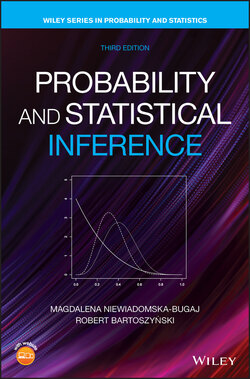Читать книгу Probability and Statistical Inference - Robert Bartoszynski - Страница 39
Example 1.20
ОглавлениеLet be any set. On one extreme, the class consisting of two sets, and , is closed under any operation so that is a field, a ‐field, and a monotone class. On the other extreme, the class of all subsets of is also closed under any operations, finite or not, and hence is a field, a ‐field, and a monotone class. These two classes of subsets of form the smallest and the largest fields (‐field, monotone class).
For any event , it is easy to check that the class , consisting of the four events , is closed under any operations: unions, intersections, and complements of members of are again members of . This class is an example of a field (‐field, monotone class) that contains the events and , and it is the smallest such field (‐field, monotone class).
On the other hand, the class , consisting of events , is a monotone class, but neither a field nor ‐field. If and are two events, then the smallest field containing and must contain also the sets , the intersections , as well as their unions and . The closure property implies that unions such as , must also belong to .
We are now ready to present the final step.
Theorem 1.4.3 For any nonempty class of subsets of , there exists a unique smallest field (‐field, monotone class) containing all sets in . It is called the field (‐field, monotone class) generated by .
Proof We will prove the assertion for fields. Observe first that if and are fields, then their intersection (i.e., the class of sets that belong to both and ) is also a field. For instance, if (, then because each is a field, and consequently . A similar argument holds for intersections and complements.
Note that if and contain the class , then the intersection also contains . The property extends to any intersection of fields containing (not only the intersections of two such fields).
Now, let be the intersection of all fields containing . We claim that is the minimal unique field containing . We have to show that (1) exists, (2) is a field containing , (3) is unique, and (4) is minimal.
For property (1) it is enough to show that there exists at least one field containing . We may take here the class of all subsets of : it is a field (as well as a ‐field and monotone class), and it contains all sets in . Property (2) follows from the fact that the intersection of fields containing is a field containing . Property (3) (i.e., uniqueness of ) follows from the fact that the result of the operation of intersection is unique.
Finally, suppose that there exists a field containing such that . Then must appear as one of the factors in the intersection defining so that . Consequently, . This completes the proof for the case of fields. The proofs for ‐fields and monotone classes are exactly the same, since an intersection of ‐fields (or monotone classes) containing is again a ‐field (monotone class) containing .
One may find it disturbing that Theorem 1.4.3 asserts the existence and uniqueness of some objects without giving a clue as to how to practically find them. In fact, the nonconstructive character of the theorem, combined with its generality, is instead a great help. As we will see in Chapter 2, the natural objects of our interest (the domains of definition of probability) will be ‐fields of events. Beyond the trivial situations of finite or countably infinite sample spaces , where one can always consider the maximal ‐field consisting of all subsets of , one is forced to restrict consideration to classes of events that form ‐fields generated by some “simple” events. The events in these ‐fields are typically of a very rich structure, and one seldom has useful criteria for distinguishing events (elements of the ‐field in question) from “nonevents,” that is, subsets of to which probabilities are not assigned. However, as shown by the two examples below, the smallest ‐field generated by some class is richer than the smallest field generated by the same class.
